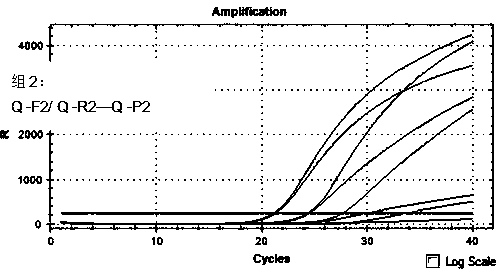A kind of rickettsia multiplex fluorescent PCR detection method
A technology of multiple fluorescence and detection methods, applied in the field of PCR detection, can solve the problems of poor sensitivity, stability and specificity of multiple PCR, and achieve the effect of improving sensitivity and shortening the detection cycle
- Summary
- Abstract
- Description
- Claims
- Application Information
AI Technical Summary
Problems solved by technology
Method used
Image
Examples
Embodiment 1
[0061] A kind of rickettsia multiplex fluorescent PCR detection method provided by the invention comprises the following steps:
[0062] (1) Extract DNA, using the classic phenol-chloroform method to extract DNA, the specific steps are as follows:
[0063] ①Put an appropriate amount of animal tissue into a 0.5 mL centrifuge tube, place in 200 µL TE buffer, vortex, centrifuge, and discard the supernatant; then add 200 µL TE and soak for 1 to 3 h to remove the influence of ethanol (fresh samples do not Soaking is required; specimens more than 2 years old are soaked overnight), centrifuged, and the supernatant discarded;
[0064] ② Add 10 µL of STE+PK solution, grind it to a solution state with a melted pipette tip, then add 190 µL (390 µL if the sample size is large) of STE+PK solution, mix well to separate the tissue; place the centrifuge tube at 55 Digest in a water bath on a rotary mixer for 2 to 3 hours to digest protein;
[0065] ③ Add an equal volume of saturated phenol,...
Embodiment 3
[0150] (7) Example 3 Methodological Verification of Multiplex Fluorescent PCR Reaction System
[0151] ①Sensitivity verification, dilute about 10copies / mL plasmid stock solution into 10 5 、10 4 , 5×10 3 、10 3 , 5×10 2 Concentration, the optimized system determines the sensitivity of the detection method, the diluted positive plasmid is used as the detection sample, and each concentration sample is repeated twice for each group;
[0152] Depend on Figure 15 , Figure 16 and Figure 17 It can be seen that the sample concentration is 5×10 3 When copies / mL, the positive detection rate is 100%; when the sample concentration is 1×10 3 When copies / mL, some samples were not detected; when the sample concentration was 5×10 2 When copies / mL, the sample positive rate was 0%, as shown in Table 12.
[0153] Table 12 Summary table of sensitivity verification results of three kinds of Rickettsia
[0154]
[0155] Note: N / A means not detected.
[0156] Take the Ct value as the...
PUM
 Login to View More
Login to View More Abstract
Description
Claims
Application Information
 Login to View More
Login to View More - R&D
- Intellectual Property
- Life Sciences
- Materials
- Tech Scout
- Unparalleled Data Quality
- Higher Quality Content
- 60% Fewer Hallucinations
Browse by: Latest US Patents, China's latest patents, Technical Efficacy Thesaurus, Application Domain, Technology Topic, Popular Technical Reports.
© 2025 PatSnap. All rights reserved.Legal|Privacy policy|Modern Slavery Act Transparency Statement|Sitemap|About US| Contact US: help@patsnap.com



